check engine light Lexus IS F 2012 Owner's Manual
[x] Cancel search | Manufacturer: LEXUS, Model Year: 2012, Model line: IS F, Model: Lexus IS F 2012Pages: 578, PDF Size: 7.07 MB
Page 6 of 578
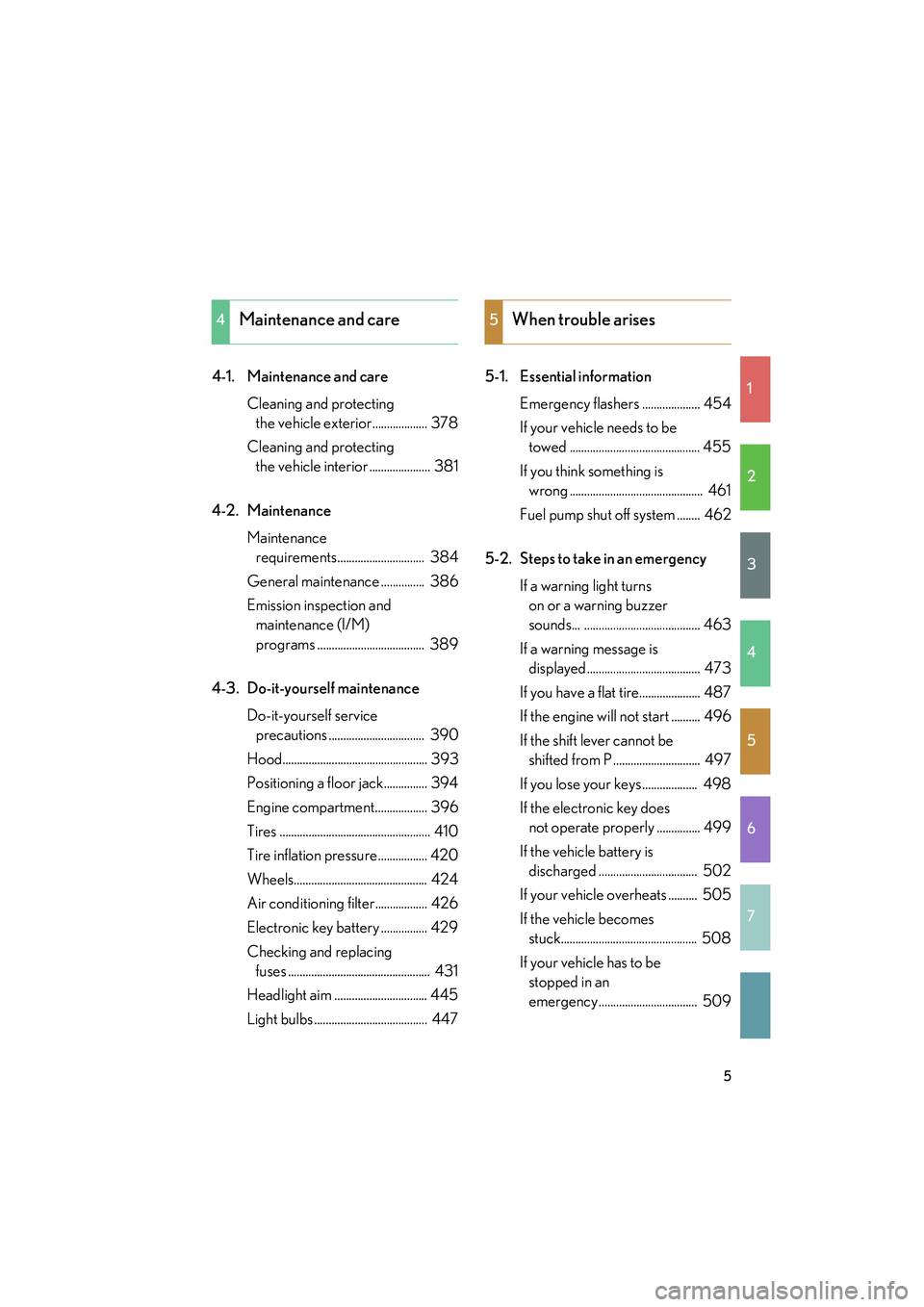
1
2
3
4
5
6
7
5
IS F_U
4-1. Maintenance and careCleaning and protecting the vehicle exterior................... 378
Cleaning and protecting the vehicle interior ..................... 381
4-2. Maintenance Maintenance requirements.............................. 384
General maintenance ............... 386
Emission inspection and maintenance (I/M)
programs ..................................... 389
4-3. Do-it-yourself maintenance Do-it-yourself service precautions ................................. 390
Hood.................................................. 393
Positioning a floor jack............... 394
Engine compartment.................. 396
Tires .................................................... 410
Tire inflation pressure................. 420
Wheels.............................................. 424
Air conditioning filter.................. 426
Electronic key battery ................ 429
Checking and replacing fuses ................................................. 431
Headlight aim ................................ 445
Light bulbs ....................................... 447 5-1. Essential information
Emergency flashers .................... 454
If your vehicle needs to be towed ............................................. 455
If you think something is wrong .............................................. 461
Fuel pump shut off system ........ 462
5-2. Steps to take in an emergency If a warning light turns on or a warning buzzer
sounds... ........................................ 463
If a warning message is displayed....................................... 473
If you have a flat tire..................... 487
If the engine will not start .......... 496
If the shift lever cannot be shifted from P .............................. 497
If you lose your keys ................... 498
If the electronic key does not operate properly ............... 499
If the vehicle battery is discharged .................................. 502
If your vehicle overheats .......... 505
If the vehicle becomes stuck............................................... 508
If your vehicle has to be stopped in an
emergency .................................. 509
4Maintenance and care5When trouble arises
Page 129 of 578
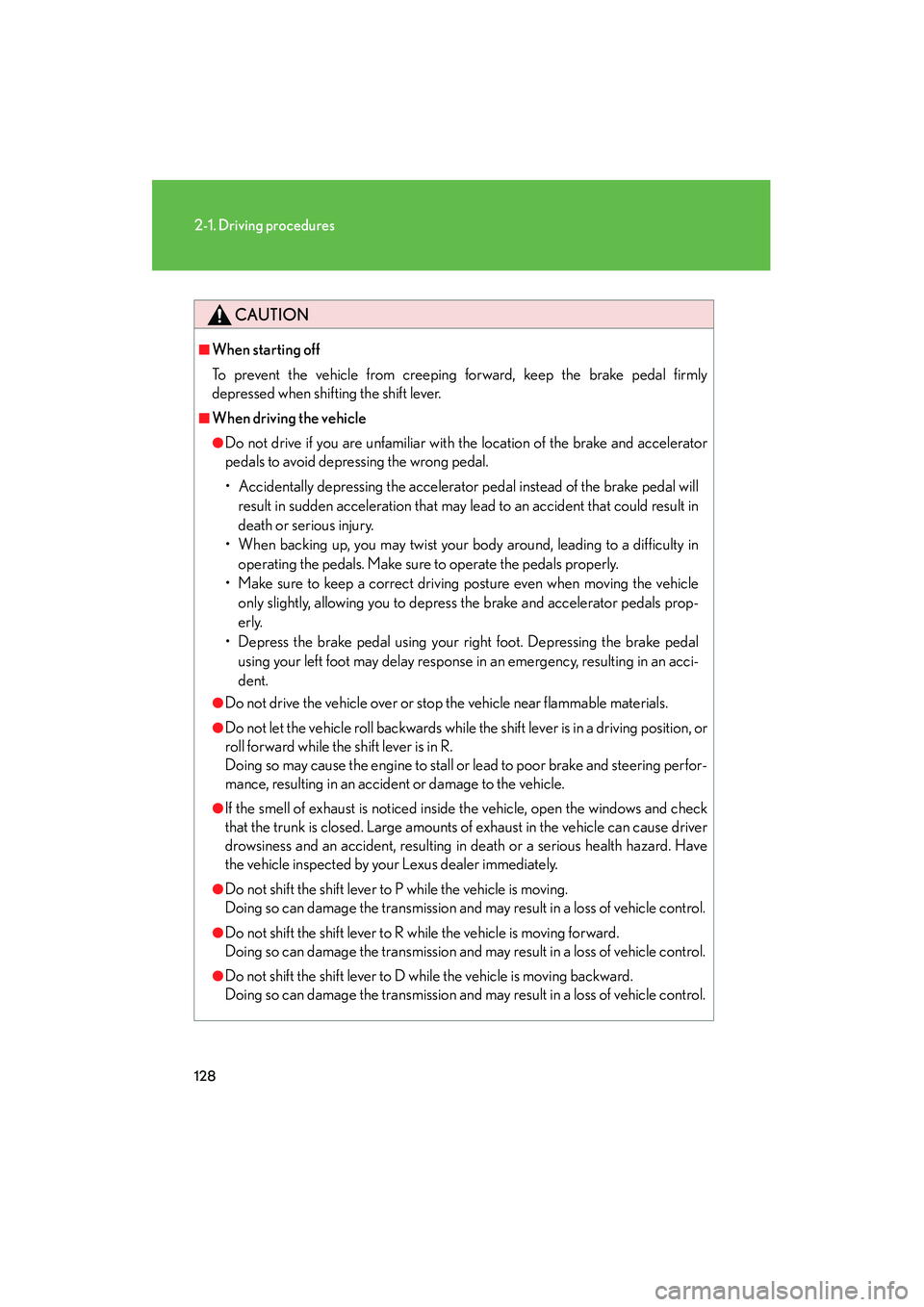
128
2-1. Driving procedures
IS F_U
CAUTION
■When starting off
To prevent the vehicle from creeping forward, keep the brake pedal firmly
depressed when shifting the shift lever.
■When driving the vehicle
●Do not drive if you are unfamiliar with the location of the brake and accelerator
pedals to avoid depressing the wrong pedal.
• Accidentally depressing the accelerator pedal instead of the brake pedal willresult in sudden acceleration that may lead to an accident that could result in
death or serious injury.
• When backing up, you may twist your body around, leading to a difficulty in operating the pedals. Make sure to operate the pedals properly.
• Make sure to keep a correct driving posture even when moving the vehicle only slightly, allowing you to depress the brake and accelerator pedals prop-
erly.
• Depress the brake pedal using your right foot. Depressing the brake pedal using your left foot may delay response in an emergency, resulting in an acci-
dent.
●Do not drive the vehicle over or stop the vehicle near flammable materials.
●Do not let the vehicle roll backwards while the shift lever is in a driving position, or
roll forward while the shift lever is in R.
Doing so may cause the engine to stall or lead to poor brake and steering perfor-
mance, resulting in an accident or damage to the vehicle.
●If the smell of exhaust is noticed inside the vehicle, open the windows and check
that the trunk is closed. Large amounts of exhaust in the vehicle can cause driver
drowsiness and an accident, resulting in death or a serious health hazard. Have
the vehicle inspected by your Lexus dealer immediately.
●Do not shift the shift lever to P while the vehicle is moving.
Doing so can damage the transmission and may result in a loss of vehicle control.
●Do not shift the shift lever to R while the vehicle is moving forward.
Doing so can damage the transmission and may result in a loss of vehicle control.
●Do not shift the shift lever to D while the vehicle is moving backward.
Doing so can damage the transmission and may result in a loss of vehicle control.
Page 130 of 578
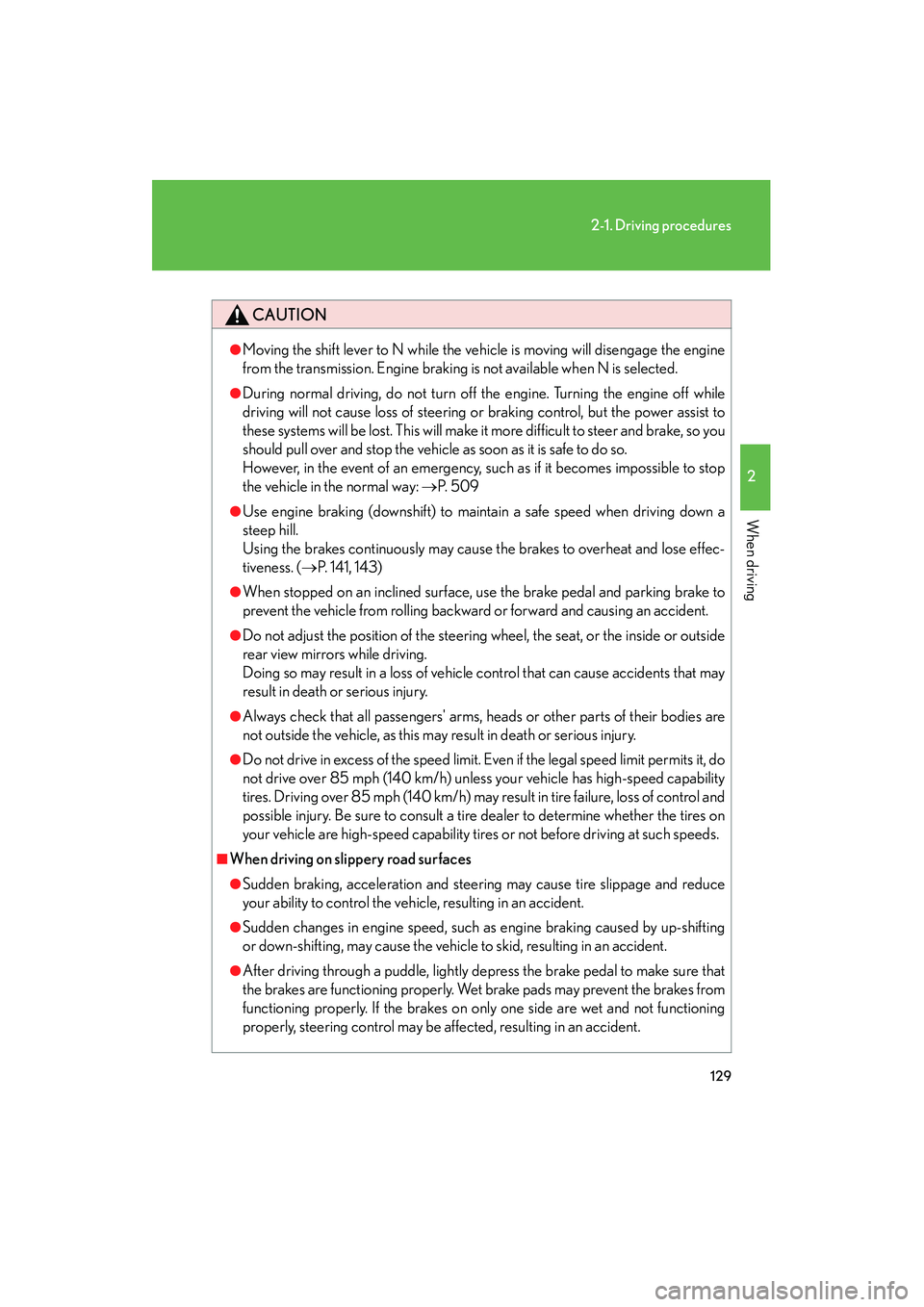
129
2-1. Driving procedures
2
When driving
IS F_U
CAUTION
●Moving the shift lever to N while the vehicle is moving will disengage the engine
from the transmission. Engine braking is not available when N is selected.
●During normal driving, do not turn off the engine. Turning the engine off while
driving will not cause loss of steering or braking control, but the power assist to
these systems will be lost. This will make it more difficult to steer and brake, so you
should pull over and stop the vehicle as soon as it is safe to do so.
However, in the event of an emergency, such as if it becomes impossible to stop
the vehicle in the normal way: → P. 5 0 9
●Use engine braking (downshift) to maintain a safe speed when driving down a
steep hill.
Using the brakes continuously may cause the brakes to overheat and lose effec-
tiveness. (→P. 141, 143)
●When stopped on an inclined surface, use the brake pedal and parking brake to
prevent the vehicle from rolling backward or forward and causing an accident.
●Do not adjust the position of the steering wheel, the seat, or the inside or outside
rear view mirrors while driving.
Doing so may result in a loss of vehicle control that can cause accidents that may
result in death or serious injury.
●Always check that all passengers' arms, heads or other parts of their bodies are
not outside the vehicle, as this may result in death or serious injury.
●Do not drive in excess of the speed limit. Even if the legal speed limit permits it, do
not drive over 85 mph (140 km/h) unless your vehicle has high-speed capability
tires. Driving over 85 mph (140 km/h) may result in tire failure, loss of control and
possible injury. Be sure to consult a tire dealer to determine whether the tires on
your vehicle are high-speed capability tires or not before driving at such speeds.
■When driving on slippery road surfaces
●Sudden braking, acceleration and steering may cause tire slippage and reduce
your ability to control the vehicle, resulting in an accident.
●Sudden changes in engine speed, such as engine braking caused by up-shifting
or down-shifting, may cause the vehicle to skid, resulting in an accident.
●After driving through a puddle, lightly depress the brake pedal to make sure that
the brakes are functioning properly. Wet brake pads may prevent the brakes from
functioning properly. If the brakes on only one side are wet and not functioning
properly, steering control may be affected, resulting in an accident.
Page 132 of 578
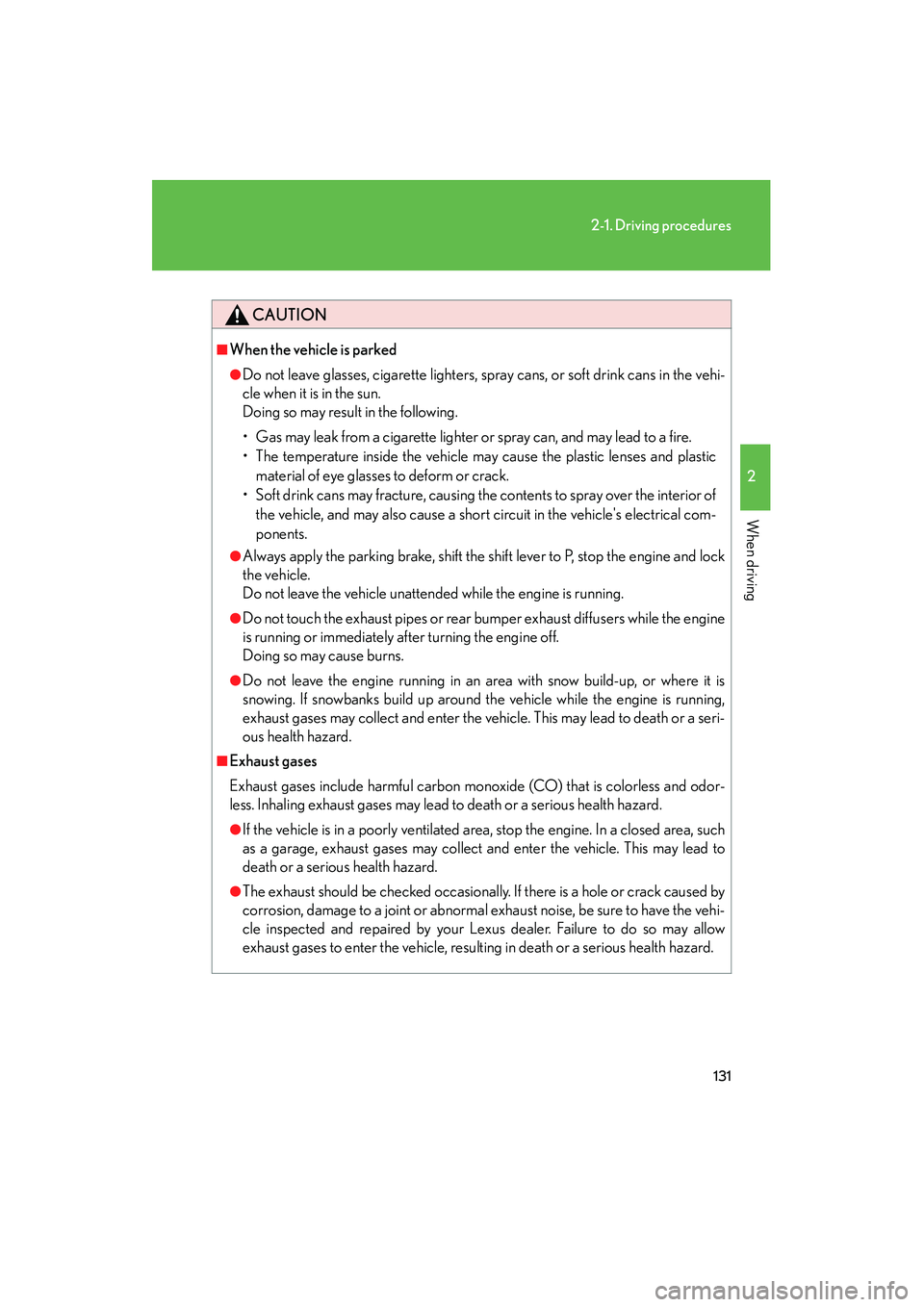
131
2-1. Driving procedures
2
When driving
IS F_U
CAUTION
■When the vehicle is parked
●Do not leave glasses, cigarette lighters, spray cans, or soft drink cans in the vehi-
cle when it is in the sun.
Doing so may result in the following.
• Gas may leak from a cigarette lighter or spray can, and may lead to a fire.
• The temperature inside the vehicle may cause the plastic lenses and plasticmaterial of eye glasses to deform or crack.
• Soft drink cans may fracture, causing the contents to spray over the interior of the vehicle, and may also cause a short circuit in the vehicle's electrical com-
ponents.
●Always apply the parking brake, shift the shift lever to P, stop the engine and lock
the vehicle.
Do not leave the vehicle unattended while the engine is running.
●Do not touch the exhaust pipes or rear bumper exhaust diffusers while the engine
is running or immediately after turning the engine off.
Doing so may cause burns.
●Do not leave the engine running in an area with snow build-up, or where it is
snowing. If snowbanks build up around the vehicle while the engine is running,
exhaust gases may collect and enter the vehicle. This may lead to death or a seri-
ous health hazard.
■Exhaust gases
Exhaust gases include harmful carbon monoxide (CO) that is colorless and odor-
less. Inhaling exhaust gases may lead to death or a serious health hazard.
●If the vehicle is in a poorly ventilated area, stop the engine. In a closed area, such
as a garage, exhaust gases may collect and enter the vehicle. This may lead to
death or a serious health hazard.
●The exhaust should be checked occasionally. If there is a hole or crack caused by
corrosion, damage to a joint or abnormal exhaust noise, be sure to have the vehi-
cle inspected and repaired by your Lexus dealer. Failure to do so may allow
exhaust gases to enter the vehicle, resulting in death or a serious health hazard.
Page 148 of 578

147
2-1. Driving procedures
2
When driving
IS F_U
Turn signal lever
■Turn signals can be operated when
The “ENGINE START STOP” switch is in IGNITION ON mode.
■If the indicators flash faster than usual
Check that a light bulb in the front or rear turn signal lights has not burned out.
Right turn
Left turn
Move and hold the lever part-
way to signal a lane change
The right hand signal will flash
until you release the lever.
Move and hold the lever part-
way to signal a lane change
The left hand signal will flash
until you release the lever.
Page 156 of 578

155
2-2. Instrument cluster
2
When driving
IS F_U
■Indicators
The indicators inform the driver of the operating state of the vehi-
cle’s various systems.
*1:These lights turn on when the “ENGINE START STOP” switch is turned
to IGNITION ON mode to indicate that a system check is being per-
formed. They will turn off after the engine is started, or after a few sec-
onds. There may be a malfunction in a system if a light does not come on,
or if the lights do not turn off. Have the vehicle inspected by your Lexus
dealer.
*2:The light flashes to indicate that the system is operating.
Turn signal indicator
( → P. 1 4 7 )Cruise control indicator
(→ P. 173, 177)
Headlight high beam indi-
cator ( →P. 1 6 4 )
(if equipped)
Intuitive parking assist
indicator ( →P. 1 9 1 )
(U.S.A.)
Headlight indicator
(→ P. 1 6 2 )Slip indicator ( →P. 1 9 8 )
(Canada)
Tail light indicator
(→ P. 1 6 2 ) VSC off indicator
(→ P. 1 9 8 )
Front fog light indicator
(→ P. 166) “TRAC OFF” indicator
(→ P. 1 9 8 )
“SNOW” indicator
(→ P. 1 4 0 ) SRS airbag on-off indica-
tor ( →P. 1 0 6 )
“SPORT” indicator
(→ P. 140, 199)
*1, 2
*1
*1
*1
Page 157 of 578

156
2-2. Instrument cluster
IS F_U
CAUTION
■If a safety system warning light does not come on
Should a safety system light such as the ABS and SRS warning light not come on
when you start the engine, this could mean that these systems are not available to
help protect you in an accident, which could result in death or serious injury. Have
the vehicle inspected by your Lexus dealer immediately if this occurs.
■Warning lights
Warning lights inform the driver of malfunctions in any of the vehi-
cle’s systems. ( →P. 463)
*: These lights turn on when the “ENGINE START STOP” switch is turned
to IGNITION ON mode to indicate that a system check is being per-
formed. They will turn off after the engine is started, or after a few sec-
onds. There may be a malfunction in a system if a light does not come on,
or if the lights do not turn off. Have the vehicle inspected by your Lexus
dealer.
(U.S.A.)(Canada)(Canada)(U.S.A.)
(Canada)(U.S.A.)(if equipped)(for
driver)(for front
passenger)
******
******
*
Page 378 of 578
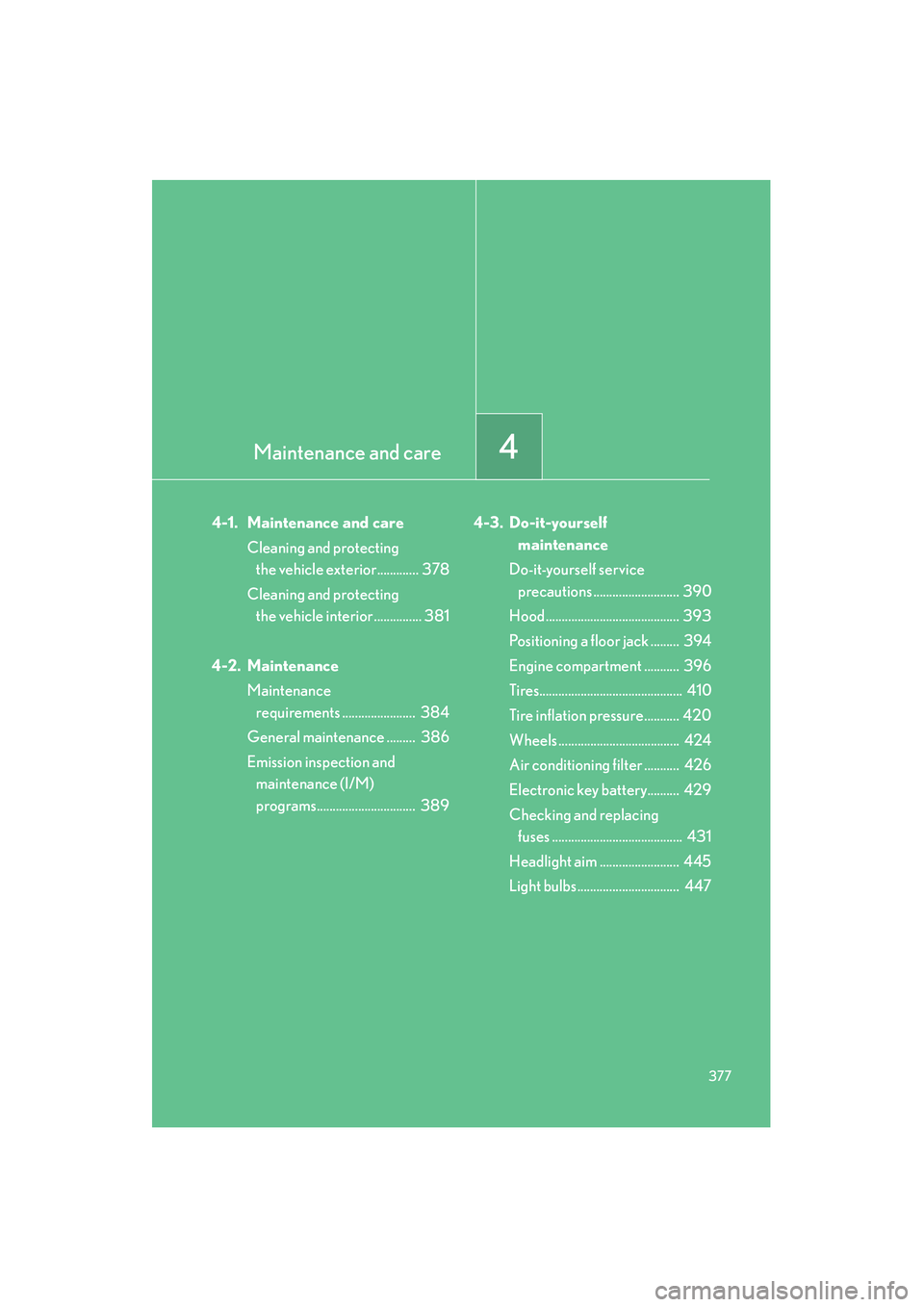
Maintenance and care4
377
IS F_U
4-1. Maintenance and careCleaning and protecting the vehicle exterior............. 378
Cleaning and protecting the vehicle interior ............... 381
4-2. Maintenance Maintenance requirements ....................... 384
General maintenance ......... 386
Emission inspection and maintenance (I/M)
programs............................... 389 4-3. Do-it-yourself
maintenance
Do-it-yourself service precautions ........................... 390
Hood .......................................... 393
Positioning a floor jack ......... 394
Engine compartment ........... 396
Tires............................................. 410
Tire inflation pressure........... 420
Wheels ...................................... 424
Air conditioning filter ........... 426
Electronic key battery.......... 429
Checking and replacing fuses ......................................... 431
Headlight aim ......................... 445
Light bulbs................................ 447
Page 446 of 578
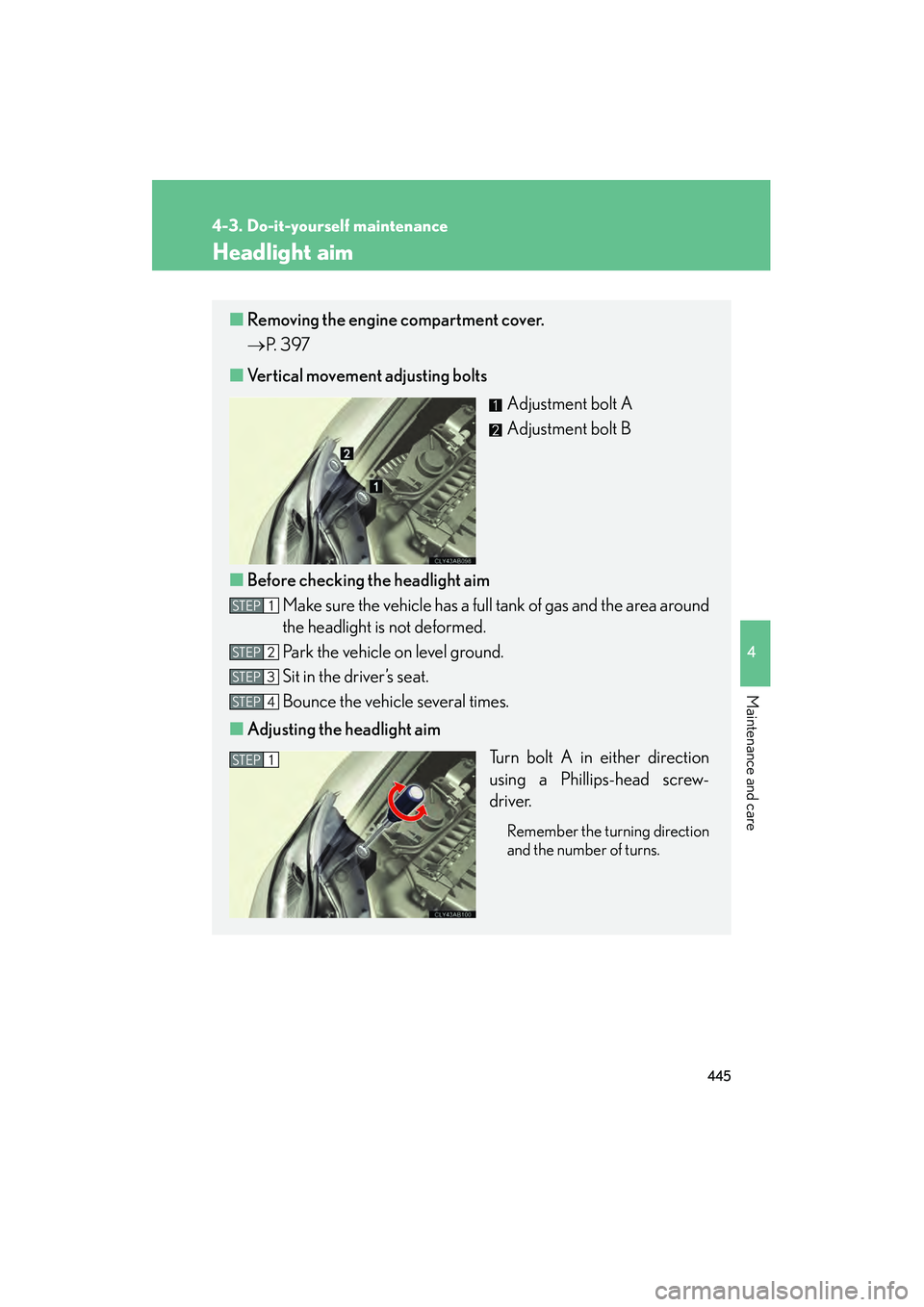
445
4-3. Do-it-yourself maintenance
4
Maintenance and care
IS F_U
Headlight aim
■Removing the engine compartment cover.
→ P. 397
■ Vertical movement adjusting bolts
Adjustment bolt A
Adjustment bolt B
■ Before checking the headlight aim
Make sure the vehicle has a full tank of gas and the area around
the headlight is not deformed.
Park the vehicle on level ground.
Sit in the driver’s seat.
Bounce the vehicle several times.
■ Adjusting the headlight aim
Turn bolt A in either direction
using a Phillips-head screw-
driver.
Remember the turning direction
and the number of turns.
STEP1
STEP2
STEP3
STEP4
STEP1
Page 470 of 578

5
When trouble arises
469
5-2. Steps to take in an emergency
IS F_U
■If the tire pressure warning system is inoperative
The tire pressure warning system will be disabled in the following conditions:
(When the condition becomes normal, the system will work properly.)
●If tires not equipped with tire pressure warning valves and transmitters are used.
●If the ID code on the tire pressure warning valves and transmitters is not regis-
tered in the tire pressure warning computer.
●If a different set of tires has been selected using the satellite switch.
●If the tire inflation pressure is 73 psi (500 kPa, 5.1 kgf/cm2 or bar) or higher.
●If electronic devices or facilities using similar radio wave frequencies are nearby.
●If a radio set at similar frequencies is in use in the vehicle.
●If there is a lot of snow or ice on the vehicle, in particular, around the wheels or
wheel housings.
●If non-genuine Lexus wheels are used. (Even if you use Lexus wheels, the tire
pressure warning system may not work properly with some types of tires.)
■If the tire pressure warning light frequently comes on after blinking for 1 minute
If the tire pressure warning light frequently comes on after blinking for 1 minute
when the “ENGINE START STOP” switch is turned to IGNITION ON mode, have
it checked by your Lexus dealer.
■Customization that can be configured at Lexus dealer
The vehicle speed linked seat belt reminder buzzer can be disabled.
(Customizable features →P. 5 3 8 )